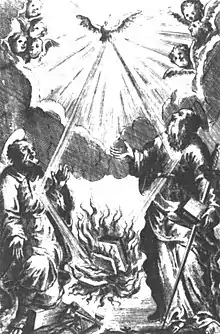The Circumcellions or Agonistici[1] (as called by Donatists) were bands of Roman Christian radicals in North Africa in the early to mid-4th century.[2] They were considered heretical by the Catholic Church.[3] They were initially concerned with remedying social grievances, but they became linked with the Donatist sect.[2] They condemned poverty and slavery, and advocated canceling debt and freeing slaves.[4]
The term "Circumcellions" may have been coined or mocked by critics who referred to them as "circum cellas euntes", they go around larders, because "they roved about among the peasants, living on those they sought to indoctrinate."[1]
Background
The Circumcellions first appeared about 317, and were active primarily in Numidia,[5] and Mauretania Sitifensis. They promoted ideas of social reform along with eschatological hopes.[6] Optatus, Bishop of Milevis, says that around 340 they started an uprising directed at creditors and slave owners. They regarded as martyrs those among them killed when the disturbance was put down. Augustine of Hippo likened them to a rustic mob encouraging violence against landlords.[7]
They regarded martyrdom as the true Christian virtue, and thus disagreed with the Episcopal see of Carthage on the primacy of chastity, sobriety, humility, and charity. Instead, they focused on bringing about their own martyrdom.
On occasion, members of this group assaulted Roman legionaries or armed travelers with simple wooden clubs to provoke them into attacking and martyring them. Others interrupted courts of law and verbally provoked the judge so that he would order their immediate execution (a normal punishment at the time for contempt of court).[8]
Views
Because it is written in the Gospel of John that Jesus had told Peter to put down his sword in the Garden of Gethsemane (John 18:11), the Circumcellions avoided bladed weapons and used clubs, which they called "Israelites". Using their "Israelites", the Circumcellions would attack random travelers on the road, while shouting "Laudate Deum!" ("Praise God!" in Latin). The motive behind these random beatings was to provoke the victims into killing them, so they would die a martyr's death.[9][10]
They preferred to be known as agonistici ("fighters" for Christ).[2] "Agonistici" are not to be confused with agnostics: the first term is based on "agon", the second on "gnosis".
In popular culture
In Umberto Eco's Baudolino (2000), the law of the Deacon of Pndapetzim is enforced by Circumcellion Nubian guards.[11]
References
- 1 2 A'Becket, John Joseph (1913). "Agonistici". In Herbermann, Charles (ed.). Catholic Encyclopedia. New York: Robert Appleton Company.
- 1 2 3 Cross, FL, ed. (2005), "Circumcellions", The Oxford dictionary of the Christian church, New York: Oxford University Press.
- ↑ Chapman, John. "Donatists." The Catholic Encyclopedia Vol. 5. New York: Robert Appleton Company, 1909. 14 March 2021
 This article incorporates text from this source, which is in the public domain.
This article incorporates text from this source, which is in the public domain. - ↑ Durant, Will (1972). The Age of Faith. New York: Simon & Schuster. pp. 47–48.
- ↑ Atkinson, J. E. "Out of Order: The Circumcellions and Codex Theodosianus 16, 5, 52", Historia: Zeitschrift Für Alte Geschichte, vol. 41, no. 4, 1992, pp. 488–499. JSTOR
- ↑ Warmington, Brian H., "Circumcelliones", Britannica
- ↑ Dossey, Leslie (2010). Peasant and Empire in Christian North Africa. University of California Press. pp. 2–3. ISBN 9780520254398.
- ↑ Gibbon, Edward (1993). "XXI – Part VII". The History of the Decline and Fall of The Roman Empire. Vol. 2. New York, NY: Everyman's Library. ISBN 0-679-42308-7.
- ↑ Gibbon, Edward (1831), The history and the decline and fall of the Roman Empire, vol. 1, p. 468.
- ↑ Robertson, James Craigie (1854), History of the Christian church, p. 182.
- ↑ Eco, Umberto (2002). Baudolino. Translated by William Weaver. New York: Harcourt. ISBN 0-15-100690-3. OCLC 49002024.
External links
- . The American Cyclopædia. 1879.
- Park, Jae-Eun (Aug 2013), "Lacking Love or Conveying Love? The Fundamental Roots of the Donatists and Augustine's Nuanced Treatment of Them", The Reformed Theological Review, 72 (2): 103–21.
